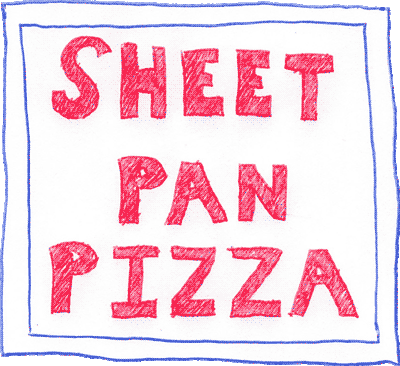

This is a recipe for a sheet-pan-sized pizza the way I like it. It has a thick, crisp crust and makes great leftovers. The crust is also taste-blasted with garlic/parmesean, because what's the point of pizza with a crappy crust?

Video coming soon!

4-6 cups all-purpose flour
1 tbsp. sugar
1 tsp. salt
1.5 cups water
1 tbsp. active dry yeast
1-2 tbsp. olive oil
4 tbsp. butter
6 garlic cloves
2 tbsp. powdered parmesan cheese
1/2 tsp. salt
8 oz. sauce
12 oz. shredded mozzarella cheese
assorted toppings (e.g. pepperoni, banana peppers)

Step 1. Scoop 1-2 cups of flour into a large bowl. Add salt and sugar. Stir to mix dry ingredients.

Step 2. In a separate bowl, mix 1.5 cups of lukewarm (Note 1) water and 1 tbsp yeast and stir well until "dissolved" (Note 2).

Step 3. When yeast is "dissolved" (Note 2), add 1-2 tbsp olive oil to the water-yeast mixture and whisk to combine. (Note 3)

Step 4. Quickly add the water-yeast-oil mixture to the flour mixture and stir to combine, until smooth and homogeneous.

Step 5. Add more flour to the dough in approximately 1 cup additions, stirring to combine each time. The dough will become more dry and eventually reach a kneadable consistency.

Step 6. Sprinkle flour on a suitable space for kneading, such as a countertop (Note 4) and dump the dough out onto it. Scoop any remaining goopies or crusties out onto the dough from the bowl. (Note 5) These will be kneaded in and homogenized into the dough mass.

Step 7. Knead the dough for ten (10) minutes. (Note 6) Sprinkle with flour as necessary to keep the dough from sticking.

Step 8. After the dough is kneaded, spray a large bowl with cooking spray (Note 7) and plop the dough into the greased bowl. You can place a layer of plastic wrap over the bowl to prevent the dough from drying out during rising. Allow the dough to rise in a warm, pleasant spot (Note 8) until risen, approximately 1 hour.

Step 9 While the dough is rising, make the flavor coating spread for the crust. Mince the garlic, or better yet, make it into a paste with a garlic plate. Mash the garlic together with the softened butter and salt. Add the parmesan cheese powder and mix to a pasty consistency. If the mixture is too thick, add a drizzle of olive oil to thin it out to s spreadable consistency.

Step 10. When dough is approximately "doubled in bulk", "punch it down" and transfer to the kneading area. Knead the dough quickly for a minute or so to uniformly distribute anything that requires further uniform distribution. Sprinkle flour around to keep everything from sticking.

Step 11. Lightly oil a sheet pan. Roll the dough out in the kneading area into an approximately-sheet-pan-sized shape. Carefully transfer the dough to the oiled pan and arrange it into the pan as necessary: thinning/thickening any thick/thin spots, preparing crust edges, etc.

Step 12. Before applying sauce, you may optionally brush a little oil onto the crust. (Note 9) Apply sauce evenly to the center area of the crust, then spread the crust edges with the previously-prepared crust flavor coating.

Step 13. Apply cheese loosely, reserving some for post-topping application. (Note 10)

Step 14. Apply toppings, followed by a sprinkle of reserved cheese.

Step 15. Bake in a 400 °F oven until done. In my oven this takes 30 minutes. During baking time I find it prudent to wash the dishes I have dirtied up to now.

Step 16. When baking is complete, allow the pizza to cool for 10 minutes before slicing. FYI, I have found the following slicing arrangement to be satisfactory:


Note 1. Fleischmann's suggests 100-110 °F water, and they are the yeast authority in my book. The word tepid also could describe this temperature range, I think.
Note 2. I use scare quotes here because the yeast won't technically dissolve. What we are looking for here is a suspension or colloid of yeast in water, which is not dissolution.
Note 3. Here is another physicosemantic note. Though "combine" adequately describes the desired result, the water-yeast-oil mixture will still be two phases of liquid. The idea is to disperse the oil into finer droplets for better incorporation into the nascent dough, rather than mixing in a two-phase oil slick. Also, oil acts as a defoamer for the water-yeast mixture!
Note 4. Or floor, if yours are clean enough to eat off of.
Note 5. The cleaner you can get the bowl, the easier it is to wash and reuse it for the rising step. I only have one large bowl, so this is what I do.
Note 6. It took me entirely too long to understand the theory of kneading. When the dough is repeatedly pressed out and folded, the original dough can be thought of as consisting of a series of sheets stretching exponentially in length. The continuous stretching develops the gluten.
Note 7. Any method of delivering a film of oil to the bowl should be equally effective, but I especially appreciate the simple ingenuity of aerosolized cooking oil.
Note 8. I used to use the top of the dryer, which was colocated with the hot water heater in a closet by the entryway and was thus the warmest place in the house. It was also easy to forget rising dough there, for what it's worth.
Note 9. I don't think this has any effect either way; I forget about half the time and notice no difference in the resulting pizza.
Note 10. It seems like a rookie mistake to put too much cheese on a homemade pizza. One quickly learns how much melt-induced flow to expect; a general rule of thumb is to make sure that sauce is still visible from above.
One final note:
Copyright 2022, Cody K. Addington
